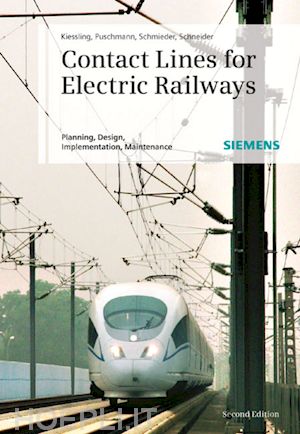

Questo prodotto usufruisce delle SPEDIZIONI GRATIS
selezionando l'opzione Corriere Veloce in fase di ordine.
Pagabile anche con Carta della cultura giovani e del merito, 18App Bonus Cultura e Carta del Docente
The authors have used their world–wide experience to provide comprehensive descriptions of configuration, mechanical and electrical design, installation and operation of contact lines for electric railways on local and long–distance transportation systems, including high–speed lines.
The book provides students and those embarking on a career in this field with a detailed presentation of the subject, including the electromechanical and structural requirements. Railway company professionals and manufacturers of contact line systems will find practical guidance in the planning and implementation of systems, as well as appropriate specifications and the technical data they will need, including standards and other regulations. Since large sections of the book are dedicated to the system aspects, consultant engineers can also use it as a basis for designing systems and interfaces to other subsystems of electric railway engineering.
1.1 Functions of traction power supply.
1.2 Traction power supply networks.
1.3 16,7 Hz traction power supply of the German Railway.
1.4 AC 25kV 50 Hz traction power supply of the Madrid–Seville line.
1.5 DC 750 V traction power supply of the Light Rail Transit System LRT Ankaray.
1.6 References.
2 Requirements and specifications.
2.1 General requirements.
2.2 Requirements resulting from operation and line parameters.
2.3 Climatic conditions.
2.4 Specifications due to pantographs.
2.5 Specifications on reliability and safety.
2.6 Environmental compatibility.
2.7 Physical characteristics of materials in contact line installations.
2.8 References.
3 Description of systems.
3.1 Definitions.
3.2 Overhead contact lines.
3.3 Conductor rails.
3.4 Overhead conductor rail installations.
3.5 References.
4 Contact line design, cross–span equipment, components and examples.
4.1 Overhead contact lines.
4.2 Cross–span equipment.
4.3 Traction power lines.
4.4 Signals for electric traction.
4.5 Guards to prevent accidental contact.
4.6 Components and elements.
4.7 Testing of components.
4.8 Systematisation of overhead contact lines and their components.
4.9 Implemented contact line systems.
4.10 References.
5 Rating overhead contact lines.
5.1 Assumptions concerning loads and stresses.
5.2 Sag.
5.3 Conductor state change equation.
5.4 Deflection due to wind.
5.5 Longitudinal span and tensioning section lengths.
5.6 References.
6 Project design.
6.1 Objective and process.
6.2 Fundamentals and initial data.
6.3 Movement of pantographs.
6.4 Contact wire height.
6.5 Contact wire stagger and radial forces.
6.6 Stagger and height of catenary wires.
6.7 Determination of span lengths.
6.8 Tensioning section length.
6.9 Arrangement of insulated overlapping sections.
6.10 Contact line above track points.
6.11 Route obstacles for wiring.
6.12 Layout plan.
6.13 Transverse profile diagram.
6.14 Longitudinal profiles.
6.15 Project documentation.
6.16 Computer supported planning.
6.17 References.
7 Cross–span structures, poles and foundations.
7.1 Loads and other actions on contact lines.
7.2 Transverse support and registration.
7.3 Poles.
7.4 Rating of cross–span supports.
7.5 Rating of poles.
7.6 Subsoil.
7.7 Foundations.
7.8 Example.
7.9 References.
8 Designs for special applications.
8.1 Introduction.
8.2 Maintenance installations.
8.3 Avoidance and removal of ice on contact lines.
8.4 Tunnel seals.
8.5 Interface between electrification systems.
8.6 Movable bridges.
8.7 Level crossings of lines fed by differing power supply systems.
8.8 Contact line design above road level crossing.
8.9 Container terminals, loading and checking tracks, railway lines in mines.
8.10 References.
9 Interaction of pantograph and overhead contact line.
9.1 Introduction.
9.2 Basic principles.
9.3 Simulation of pantograph overhead contact line interaction.
9.4 Measurements and tests.
9.5 Effects of contact line design.
9.6 Effects of pantograph designs.
9.7 Collector strip and contact wire materials.
9.8 Conclusions.
9.9 References.
10 Currents and voltages.
10.1 Electrical characteristics of contact lines.
10.2 Voltages in contact line networks.
10.3 Electric traction loads.
10.4 Line feeding circuits.
10.5 References.
11 Current–carrying capacity and protective provisions.
11.1 Current–carrying capacity.
11.2 Effects of temperature on contact wire characteristics.
11.3 Line protection and fault location.
11.4 References.
12 Current return circuit and earthing.
12.1 Introduction.
12.2 Terms and Definitions.
12.3 Design principles and requirements.
12.4 Return currents and rail potentials.
12.5 Direct–current traction systems.
12.6 Alternating current traction systems.
12.7 References.
13 Interferences.
13.1 Introduction.
13.2 Interferences due to electric traction systems.
13.3 Coupling mechanisms.
13.4 Electric and magnetic fields in the vicinity of traction contact lines.
13.5 Conclusions.
13.6 References.
14 Construction, management and maintenance.
14.1 Introduction.
14.2 Construction.
14.3 Management.
14.4 Wear and ageing.
14.5 Maintenance.
14.6 Recycling and disposal.
14.7 Equipment for Installation and maintenance.
14.8 Life cycle considerations.
14.9 References.
Appendix 1: Standards and regulations.
Appendix 2: Frequently used abbreviations.











Il sito utilizza cookie ed altri strumenti di tracciamento che raccolgono informazioni dal dispositivo dell’utente. Oltre ai cookie tecnici ed analitici aggregati, strettamente necessari per il funzionamento di questo sito web, previo consenso dell’utente possono essere installati cookie di profilazione e marketing e cookie dei social media. Cliccando su “Accetto tutti i cookie” saranno attivate tutte le categorie di cookie. Per accettare solo deterninate categorie di cookie, cliccare invece su “Impostazioni cookie”. Chiudendo il banner o continuando a navigare saranno installati solo cookie tecnici. Per maggiori dettagli, consultare la Cookie Policy.